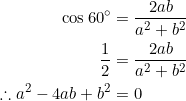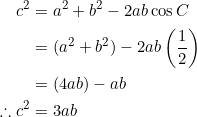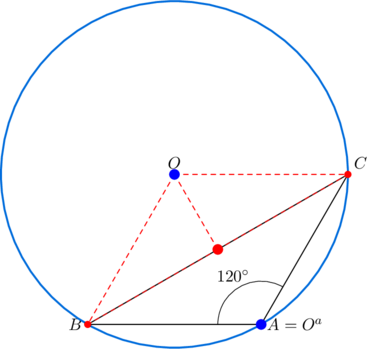-
 ,
, 
-
 ,
, 
-
 ,
, 
What makes them special is the fact that their side-lengths ![]() satisfy the modified Pythagorean identity
satisfy the modified Pythagorean identity
(1) ![]()
with the accompanying equivalent descriptions. The first triangle has already appeared on August 14 and on October 14. The second triangle is making its debut here.
Since ![]() , the conclusion follows from one of the equivalent statements here.
, the conclusion follows from one of the equivalent statements here.
In example 1 above we saw that the side-lengths satisfy equation (1). As such ![]() , by one of the equivalent statements here. So:
, by one of the equivalent statements here. So:

A direct computation of the side-lengths ![]() and
and ![]() can also be used to prove the above relationship, but that’s a longer procedure.
can also be used to prove the above relationship, but that’s a longer procedure.
By example 2 above we had ![]() . Re-write as
. Re-write as ![]() . Using one of the equivalent statements here, we know that
. Using one of the equivalent statements here, we know that ![]() .
.
![]()
One can also prove this by a direct computation of the circumradius ![]() and the fact that
and the fact that ![]() . Definitely a longer procedure.
. Definitely a longer procedure.
Let’s use the cosine formula and the fact that ![]() :
:

To show that ![]() , re-write
, re-write ![]() as
as ![]() and then use the fact that
and then use the fact that ![]() just proved.
just proved.
Take the tiny triangle ![]() where the vertices are located at
where the vertices are located at ![]() ,
, ![]() , and
, and ![]() .
.

Takeaway
Let ![]() be the side-lengths of
be the side-lengths of ![]() , and let
, and let ![]() be the radius of its circumscribed circle. If equation (1) holds, then the following statements are equivalent:
be the radius of its circumscribed circle. If equation (1) holds, then the following statements are equivalent:

 .
.
Note the first one.
Task
- (Late fifties) In a non-right triangle
 , let
, let  be the side-lengths,
be the side-lengths,  the altitudes,
the altitudes,  the feet of the altitudes from the respective vertices,
the feet of the altitudes from the respective vertices,  the circumradius,
the circumradius,  the circumcenter,
the circumcenter,  the nine-point center,
the nine-point center,  the orthocenter,
the orthocenter,  the midpoint of side
the midpoint of side  ,
,  the reflection of
the reflection of  over side
over side  ,
,  the reflection of
the reflection of  over side
over side  , and
, and  the reflection of
the reflection of  over side
over side  . PROVE that the following fifty-eight statements are equivalent:
. PROVE that the following fifty-eight statements are equivalent:




























 or
or 




 is congruent to
is congruent to 
 is congruent to
is congruent to 
 is isosceles with
is isosceles with 
 is isosceles with
is isosceles with 
 is right angled at
is right angled at 
 is the circumcenter of
is the circumcenter of 
 is right-angled at
is right-angled at 
 is right-angled at
is right-angled at 
- quadrilateral
 is a rectangle
is a rectangle - the points
 are concyclic with
are concyclic with  as diameter
as diameter - the reflection
 of
of  over
over  lies internally on
lies internally on 
- the reflection
 of
of  over
over  lies externally on
lies externally on 
- radius
 is parallel to side
is parallel to side 
 is the reflection of
is the reflection of  over side
over side 
- the nine-point center lies on

- the orthic triangle is isosceles with

- the geometric mean theorem holds
- the bisector of
 has length
has length  , where
, where 
- the orthocenter is a reflection of vertex
 over side
over side 
- segment
 is tangent to the circumcircle at point
is tangent to the circumcircle at point 
- median
 has the same length as the segment
has the same length as the segment 
- the bisector
 of
of  is tangent to the nine-point circle at
is tangent to the nine-point circle at 
 is a convex kite with diagonals
is a convex kite with diagonals  and
and 
- altitude
 is tangent to the nine-point circle at
is tangent to the nine-point circle at 
- segment
 is tangent to the nine-point circle at
is tangent to the nine-point circle at  .
.
( short of the target.)
short of the target.)
- (Extra feature) If
 satisfies equation (??), PROVE that its nine-point center
satisfies equation (??), PROVE that its nine-point center  divides
divides  in the ratio
in the ratio  .
.